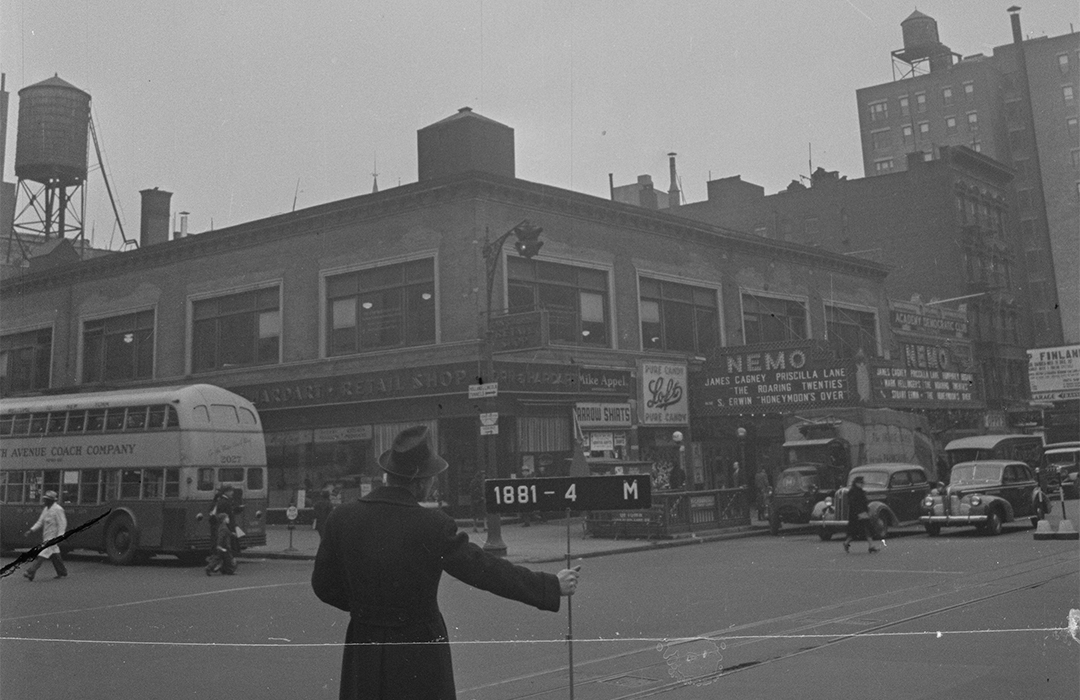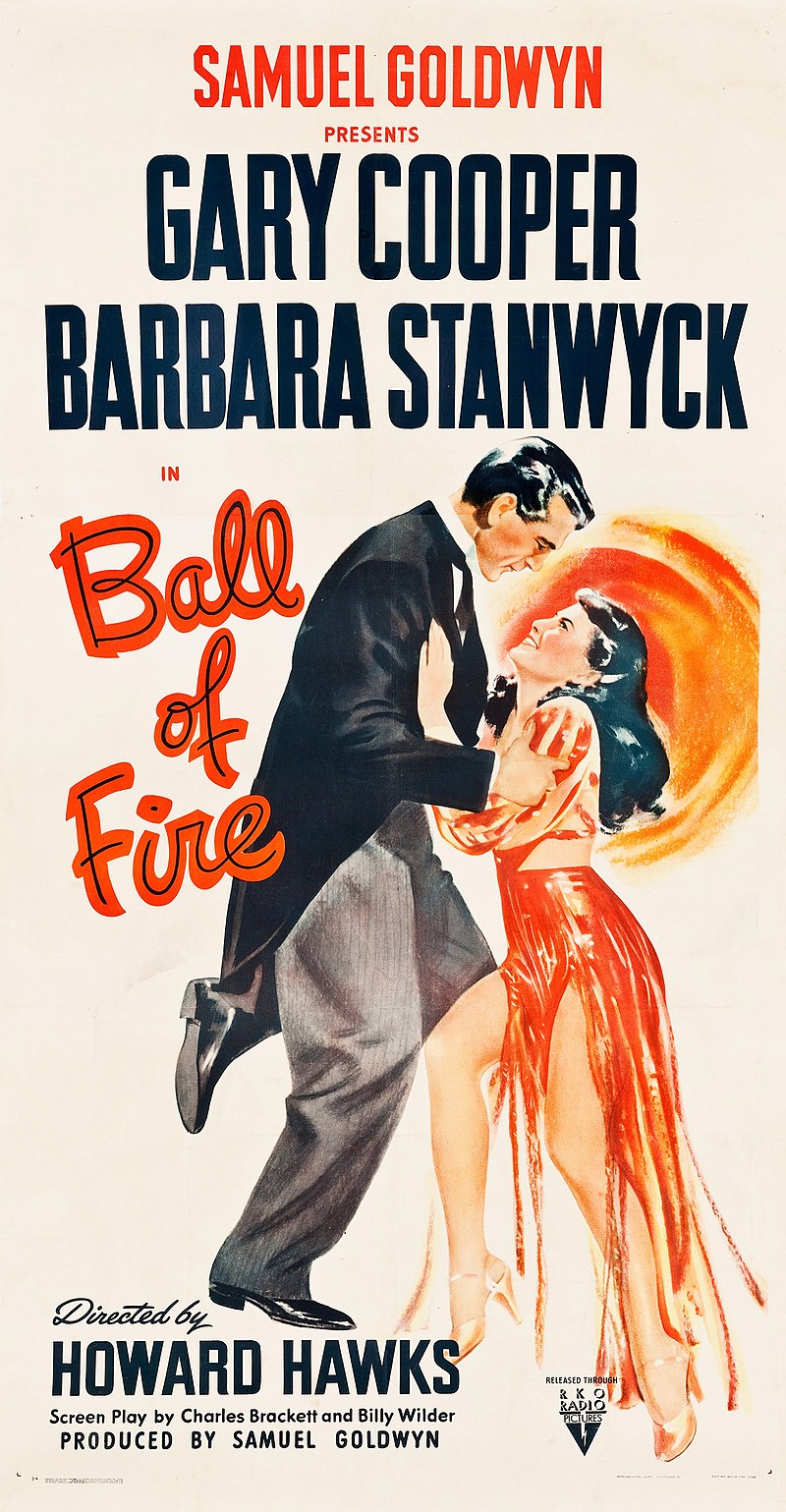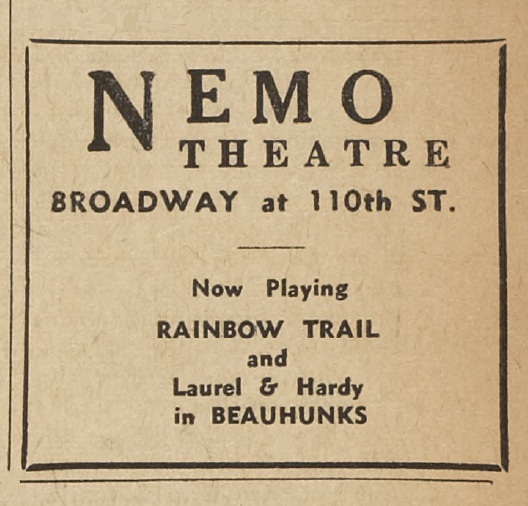
The Nemo Theater
by Tom Miller
When Swiss-born brewer August Schmid died in 1889, he left his wife Josephine a fortune and a controlling interest in the Lion Brewery on West 108th Street. She also inherited the nearby Lion Palace Music Hall, at the southeast corner of the Boulevard (later Broadway) and West 110th Street.
By the first decade of the 20th century, the neighborhood around the Lion Palace Music Hall was nearly fully developed. In 1910 Josephine Schmidt leased the music hall to the Broadway Varieties Co., headed by William Fox. Fox owned a circuit of more than a dozen theaters in the New York area. Renamed the Nemo Theatre, it opened on the night of September 27, 1910. Variety took notice, saying, “The audience was one of real ‘class’…dinner coats were in evidence in the auditorium.”
The venture was successful, and the following year, in October, Josephine Schmidt sold the property to William Fox. On October 8, The New York Times reported that the theater “will be enlarged to over double its capacity, and a roof garden for Summer entertainments added.” Theater architect Thomas W. Lamb was hired to make the renovations. The two-story structure was completed in the summer of 1911. An early example of Lamb’s theater designs, the Nemo was relatively understated. The second floor, with its vast windows, held a single, large room. A shop at ground level faced the side street. The New York Times noted, “The new theatre is in the centre of one of the choicest apartment house sections on the upper west side.”
“The audience was one of real ‘class’…dinner coats were in evidence in the auditorium.”
The Nemo Theatre presented vaudeville shows. Audiences were entertained by a variety of acts throughout the evening, from jugglers to trained animals, and from singers and comedy skits.
In 1917 the upper floor was occupied by a tearoom, while a cigar store occupied the 110th Street shop. The Nemo Theatre’s auditorium was still a single level with seating for 950. In March 1918, architect Frank Hausle was commissioned to install a balcony. The improvement nearly doubled the seating capacity. Around the same time, The Royal, a Chinese-American restaurant took over the second floor.
As it did during wartime, the Government released propaganda films following the enactment of Prohibition in 1920. A critic writing in The Evening World expressed his opinion of the practice on March 5, 1920. “Prohibition propaganda is appearing in the films. Robert Warick is the star in one story. William Fox’s Nemo Theatre is showing it. It would drive a man to drink.”
By the Depression years, the Nemo Theatre was purely a motion picture venue. It was the scene of a terrifying incident on the night of January 10, 1932. Two men hid in the theater after the final show, which ended around 11:00. George Clark, the porter, locked the doors, leaving only him and the assistant manager, Richard Dixon, in the building. The interlopers suddenly appeared in the office brandishing weapons. They forced Dixon to open the safe and turn over the metal box containing the day’s receipts, nearly $40,000 by today’s conversion. The robbers disappeared into the night on Broadway.
In the late 1930’s, the Nemo Theatre joined other motion picture venues throughout the city that offered afternoon films on the weekends which were “endorsed as especially suitable for young persons by the Schools Motion Picture Committee.” The group was composed of New York City teachers and parents. The films approved for screening here on the weekend of February 11, 1938 were Stand-In and Navy Blue and Gold.
The building received a make-over in 1940. Renamed the New Nemo, it touted being “scientifically air conditioned.”
On December 7, 1941, the Japanese bombed Pearl Harbor and three days later America entered World War II. The wave of patriotism that followed reached the New Nemo Theatre. On March 10, 1942, the Barnard Bulletin reported, “Benefit performances of the moving picture Ball of Fire, featuring Gary Cooper and Barbara Stanwyck, are being given this week at the Nemo Theatre…The War Relief Committee, which sends aid to Greece, Britain, China, and the American Red Cross, hopes to sell one thousand tickets.
The building received a make-over in 1940. Renamed the New Nemo, it touted being “scientifically air conditioned.”
A less serious one-week engagement came in May of that year when Walt Disney’s animated masterpiece Fantasia, with music conducted by Leopold Stokowski, opened. The advertisement on May 1 noted the film was “in glorious technicolor.” The triple bill included Valley of the Sun, and Lend A Paw, starring Mickey Mouse and Pluto.
In 1946 the upper floor of the building became home to The Council Club for Older People. The New York Times explained on April 1, “It provides books and magazines, music, games, English lessons and arts and crafts instruction without charge.” The seniors club was a success. The following year a picnic at Pelham Bay Park was arranged. On September 4, 1947, The New York Times wrote, “124 white-haired men and women, some leaning on canes and all clutching lunches” clambered onto four buses for the trip. The outing had at least one unexpected outcome. “Romance also bloomed for Mrs. Martha Herschberger, 72, and Henry Hirschfield, 81, who held hands and carved their initials in a tree trunk.”
The New Nemo Theatre screened its last film in 1963. On January 21, 1964, The New York Times announced the opening of the 9,000 square-foot Daitch-Shopwell supermarket. “The unit will be situated on the site of the former Nemo Theatre,” said the article. The building survived until 2002, when it was replaced by a modern apartment building.
Tom Miller is a social historian and blogger at daytoninmanhattan.blogspot.com




